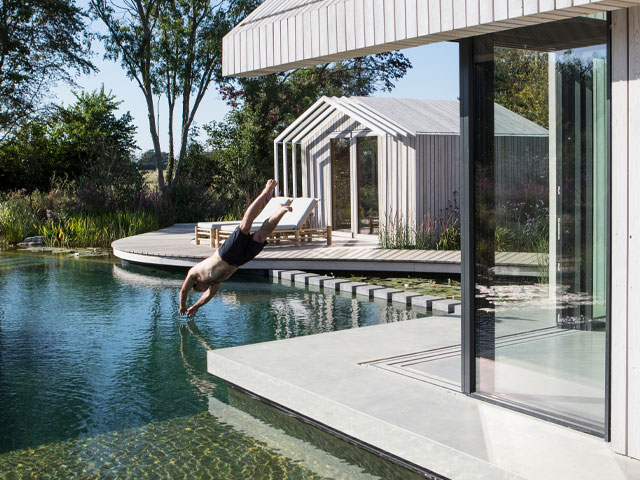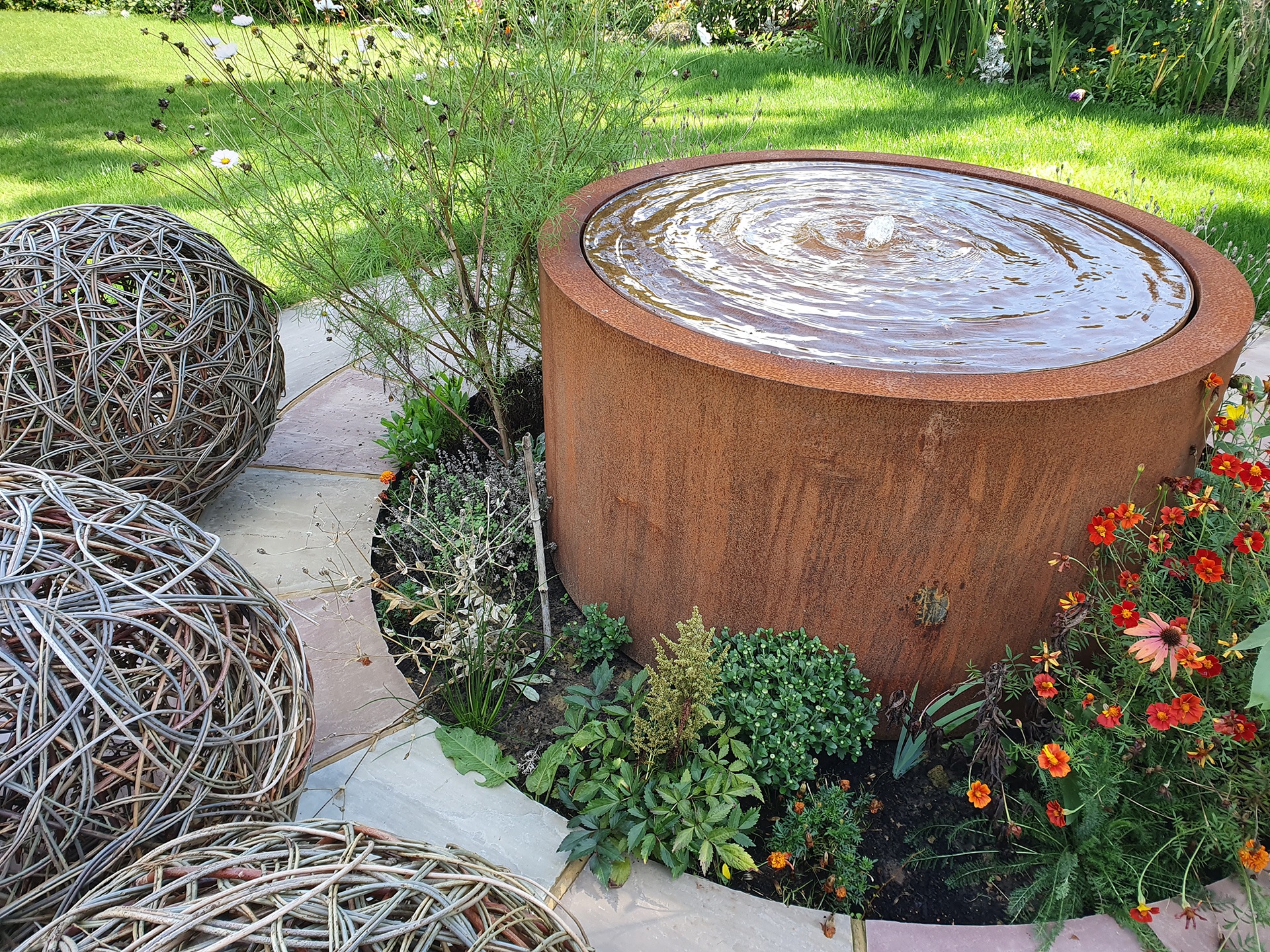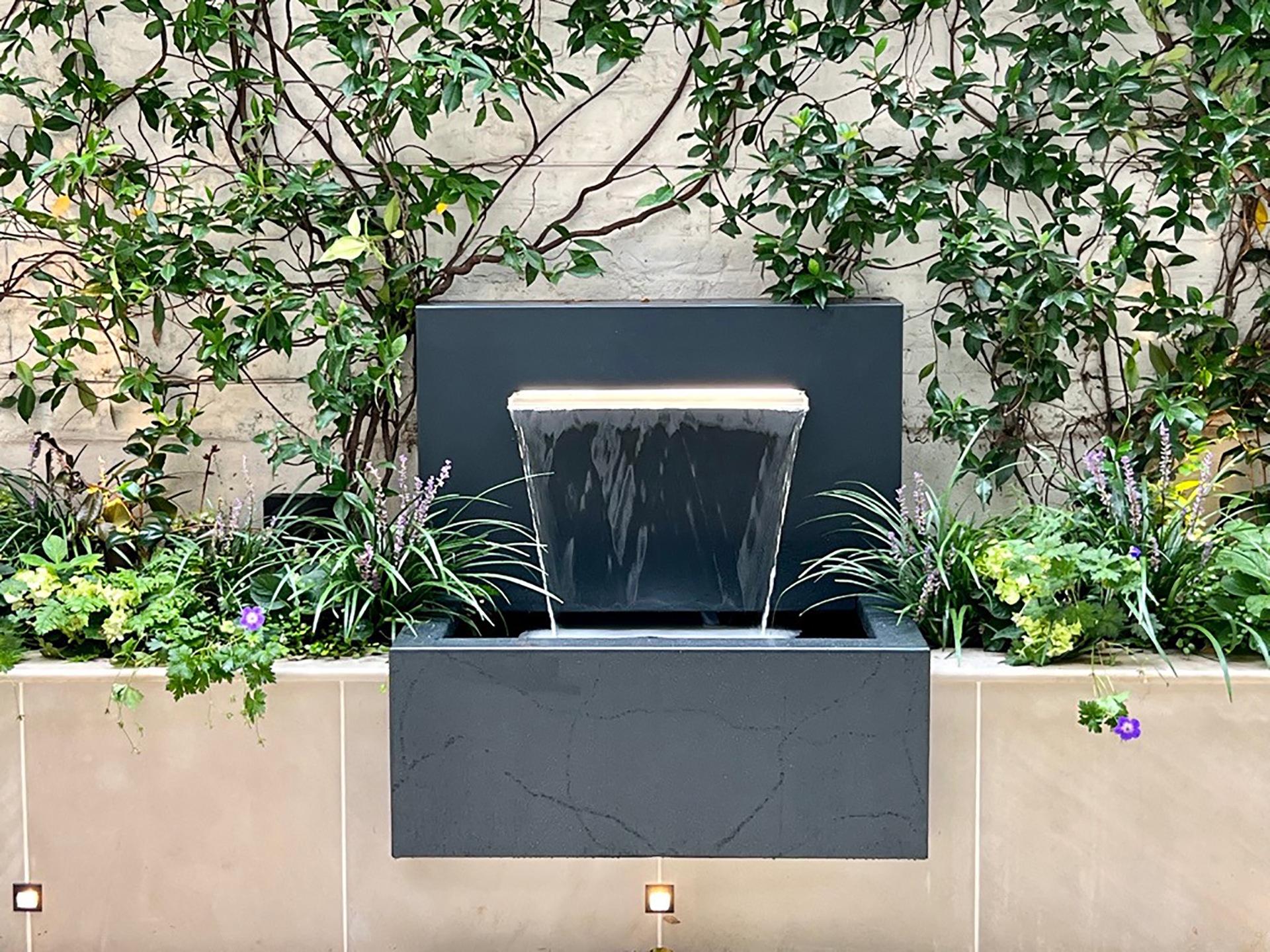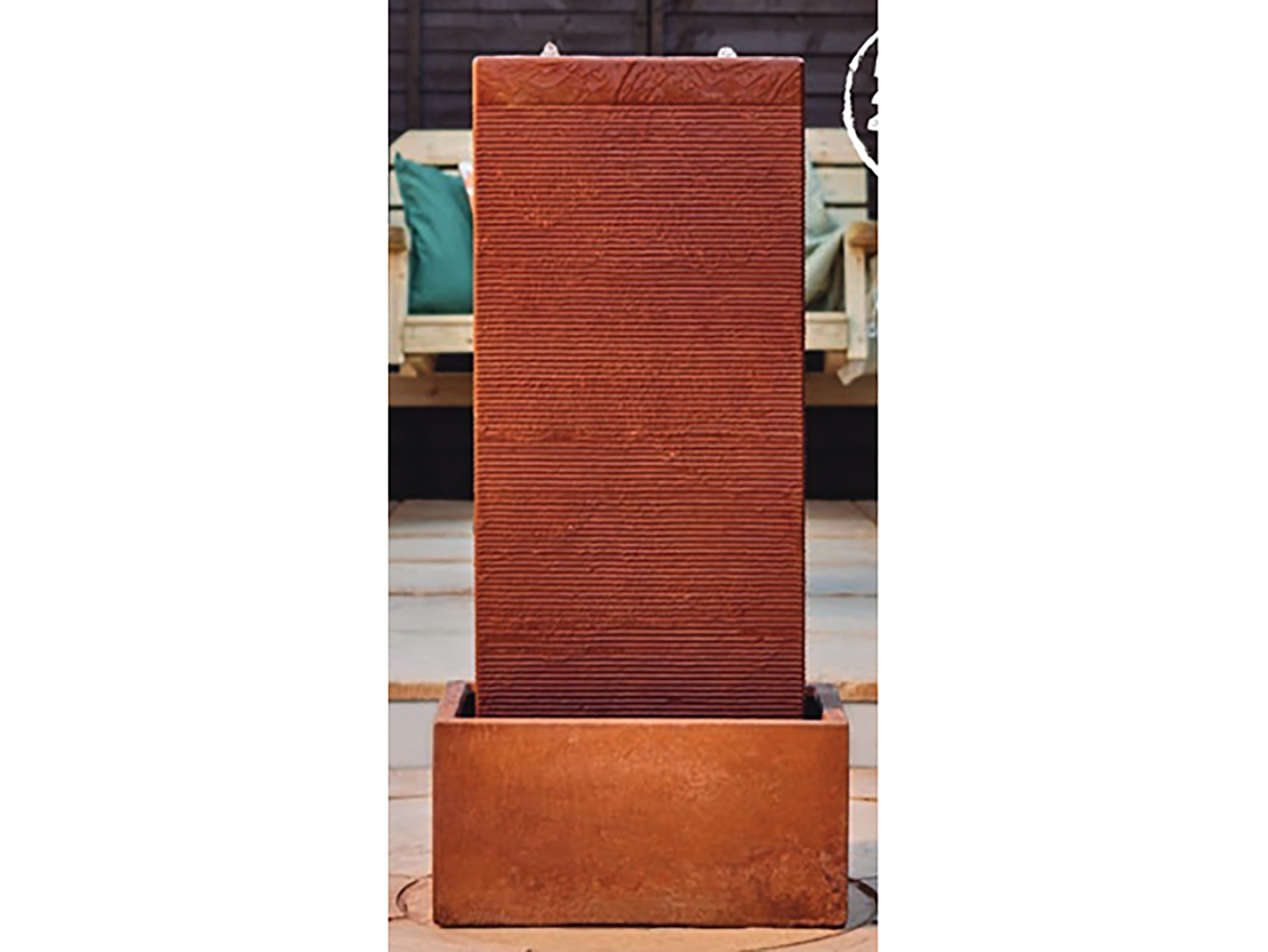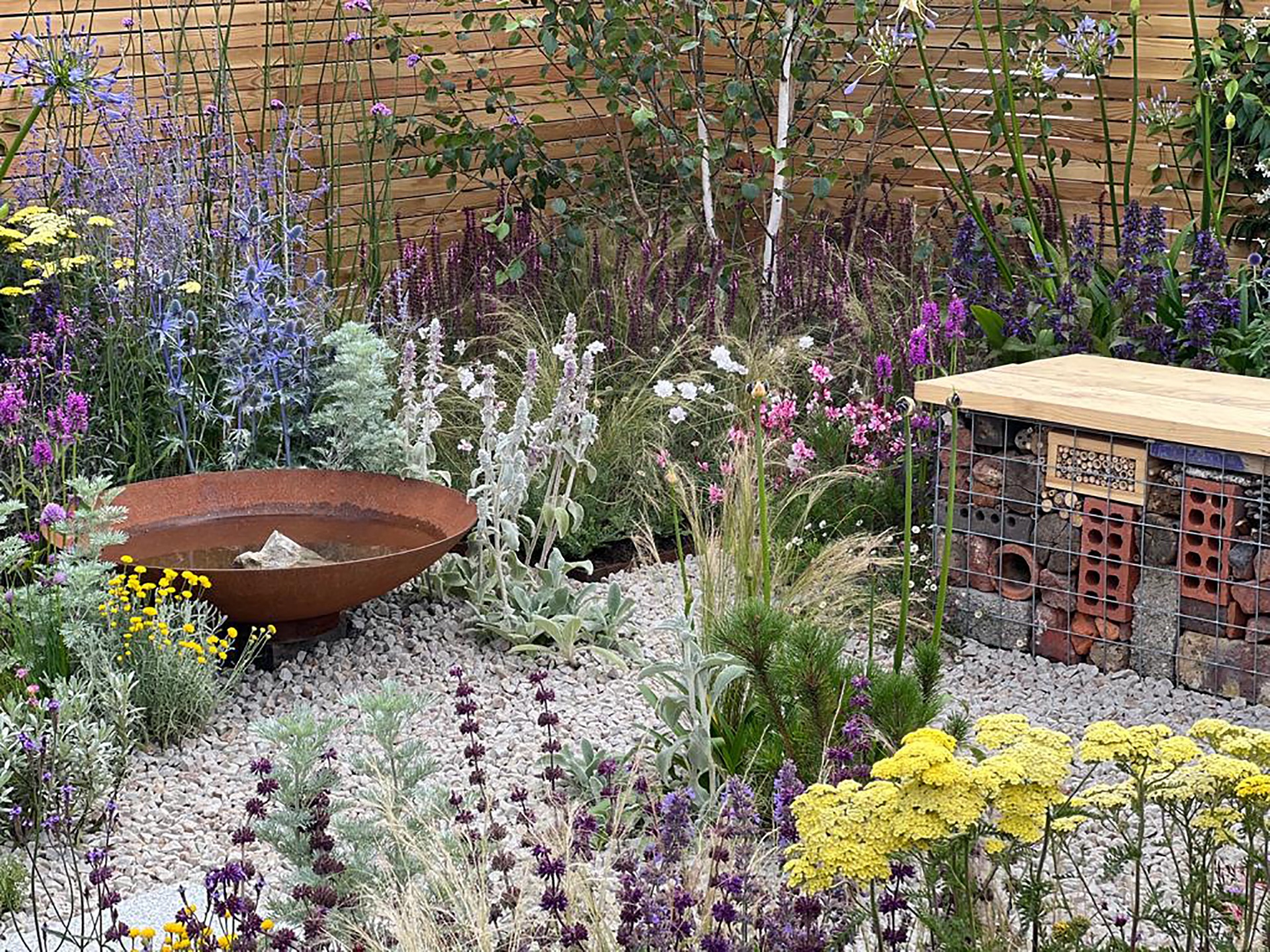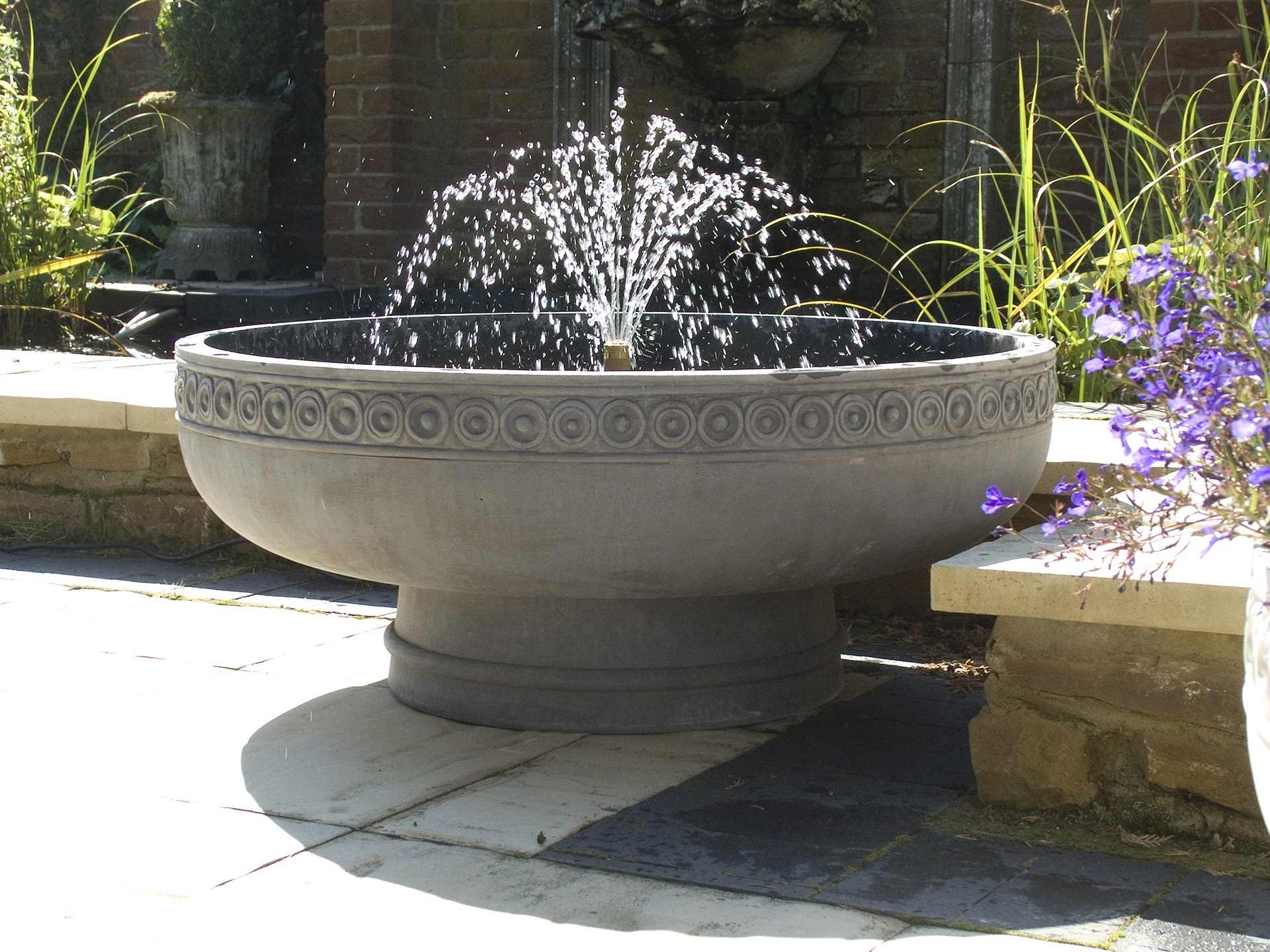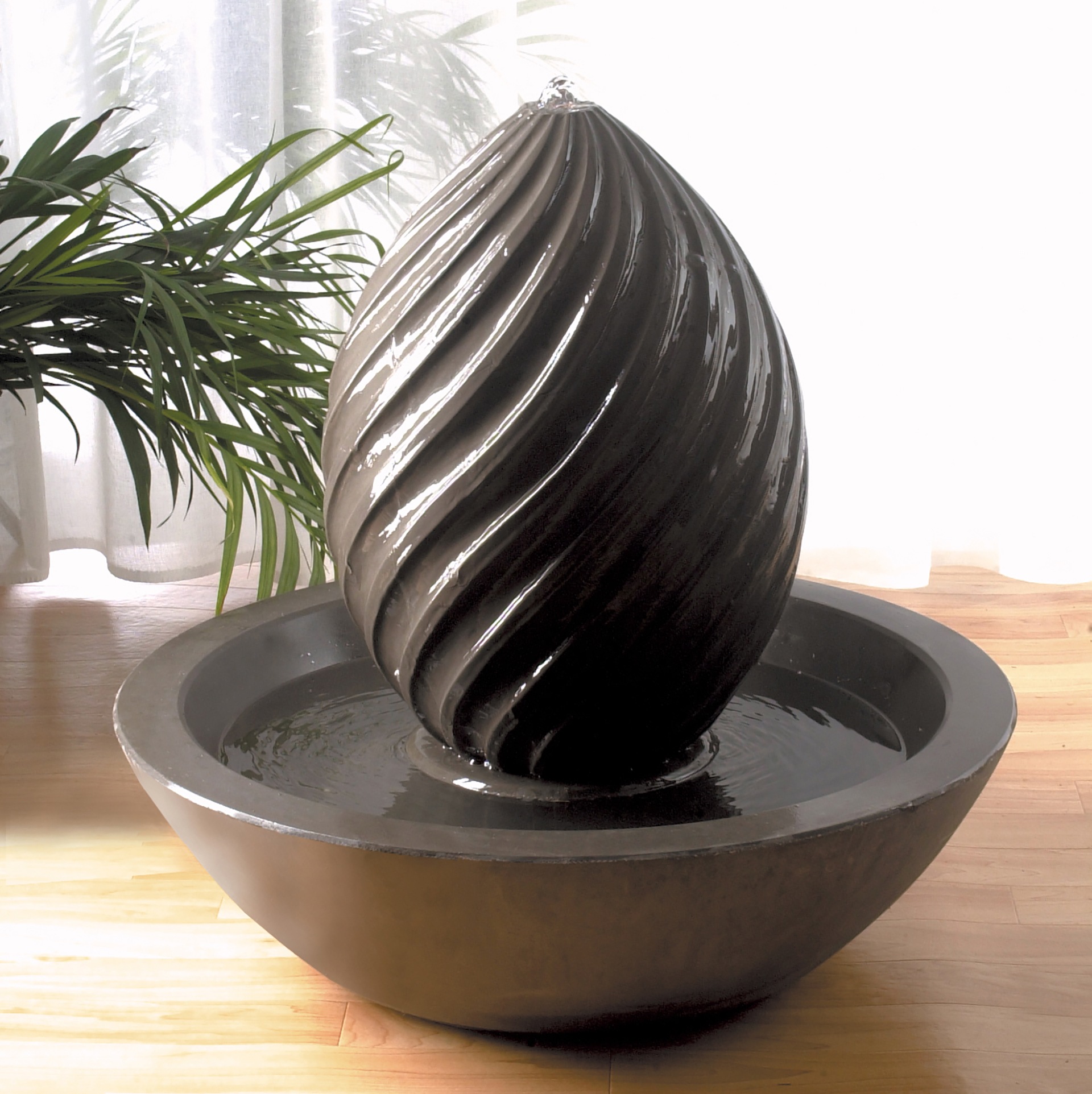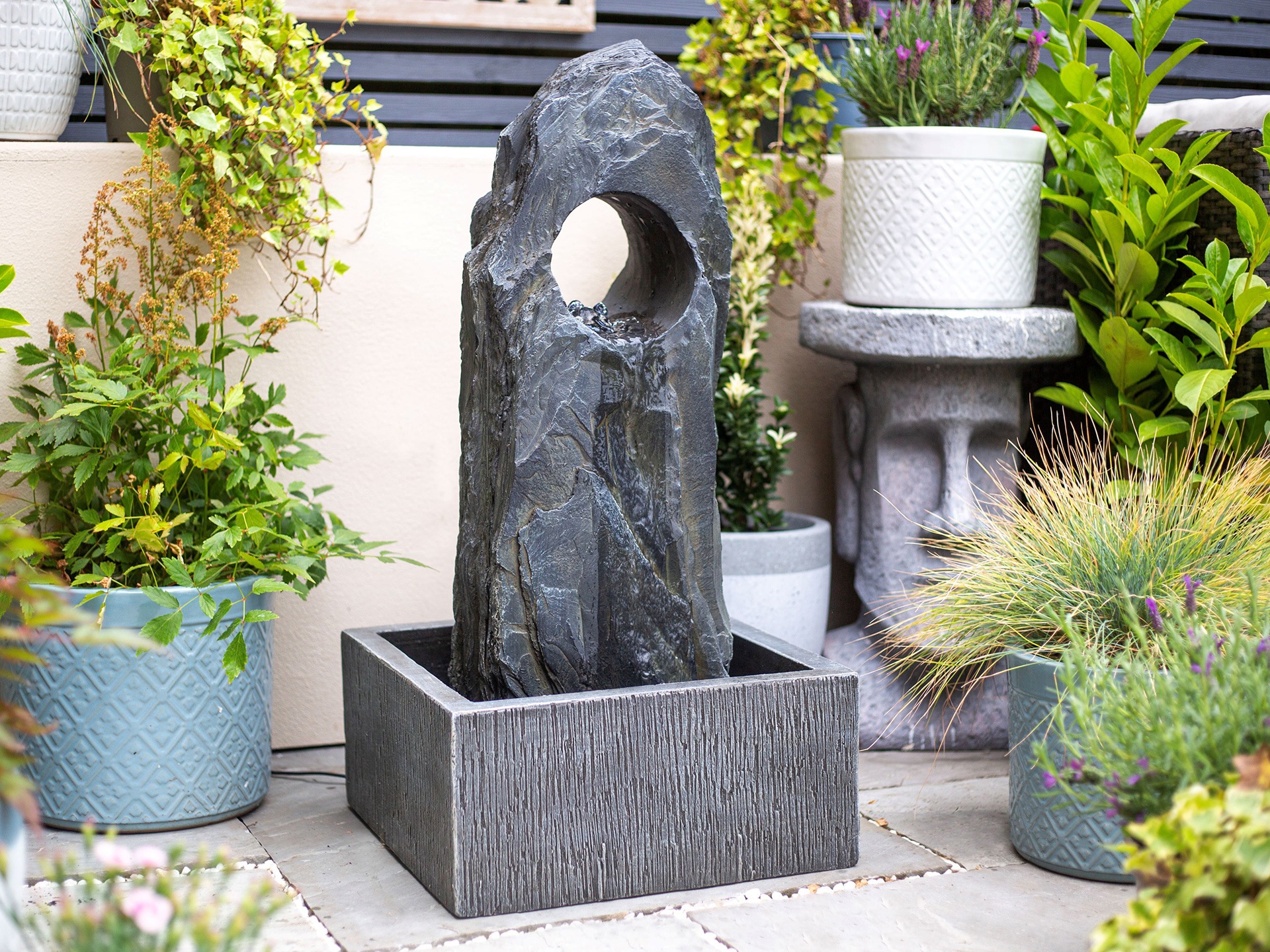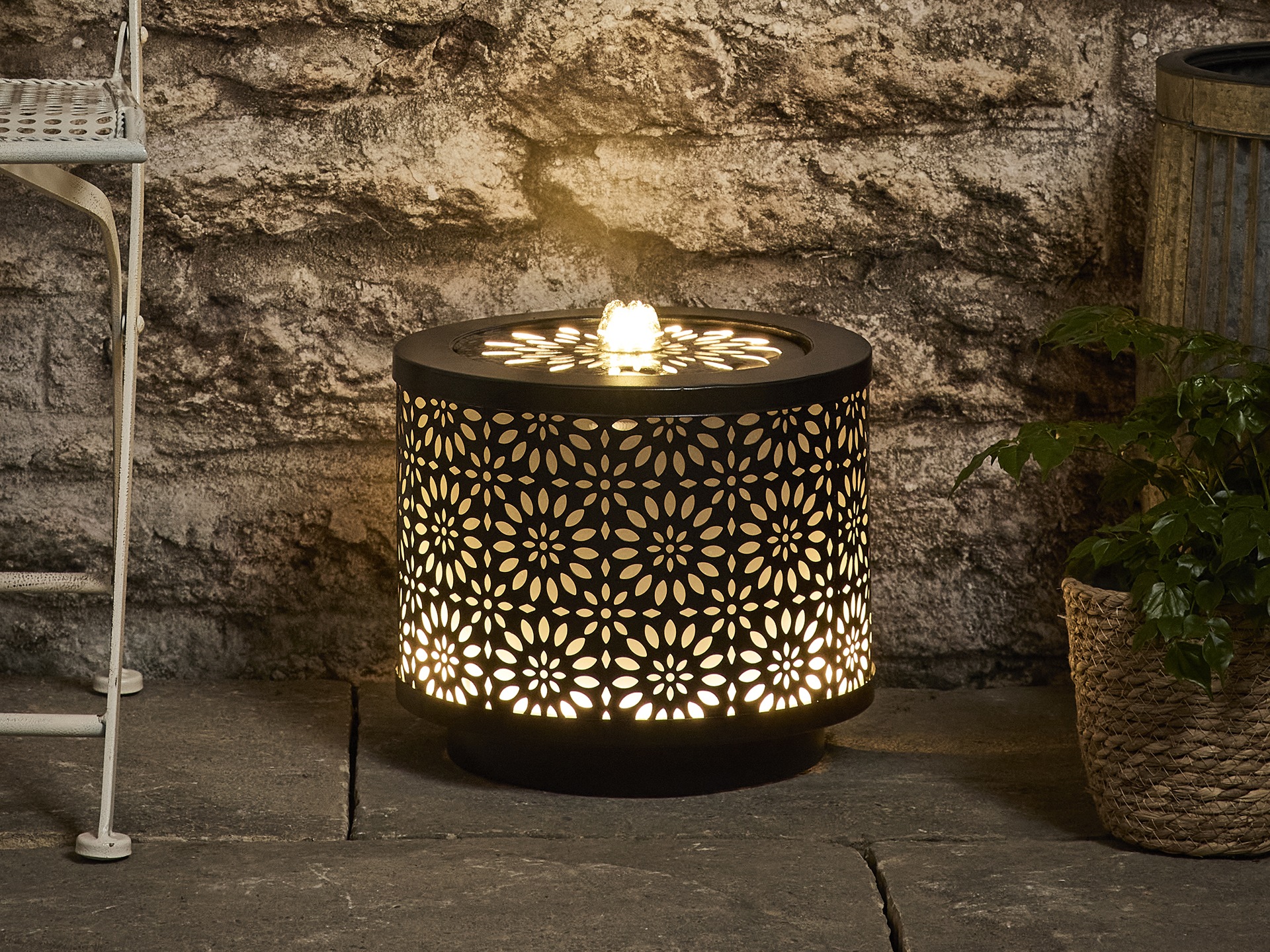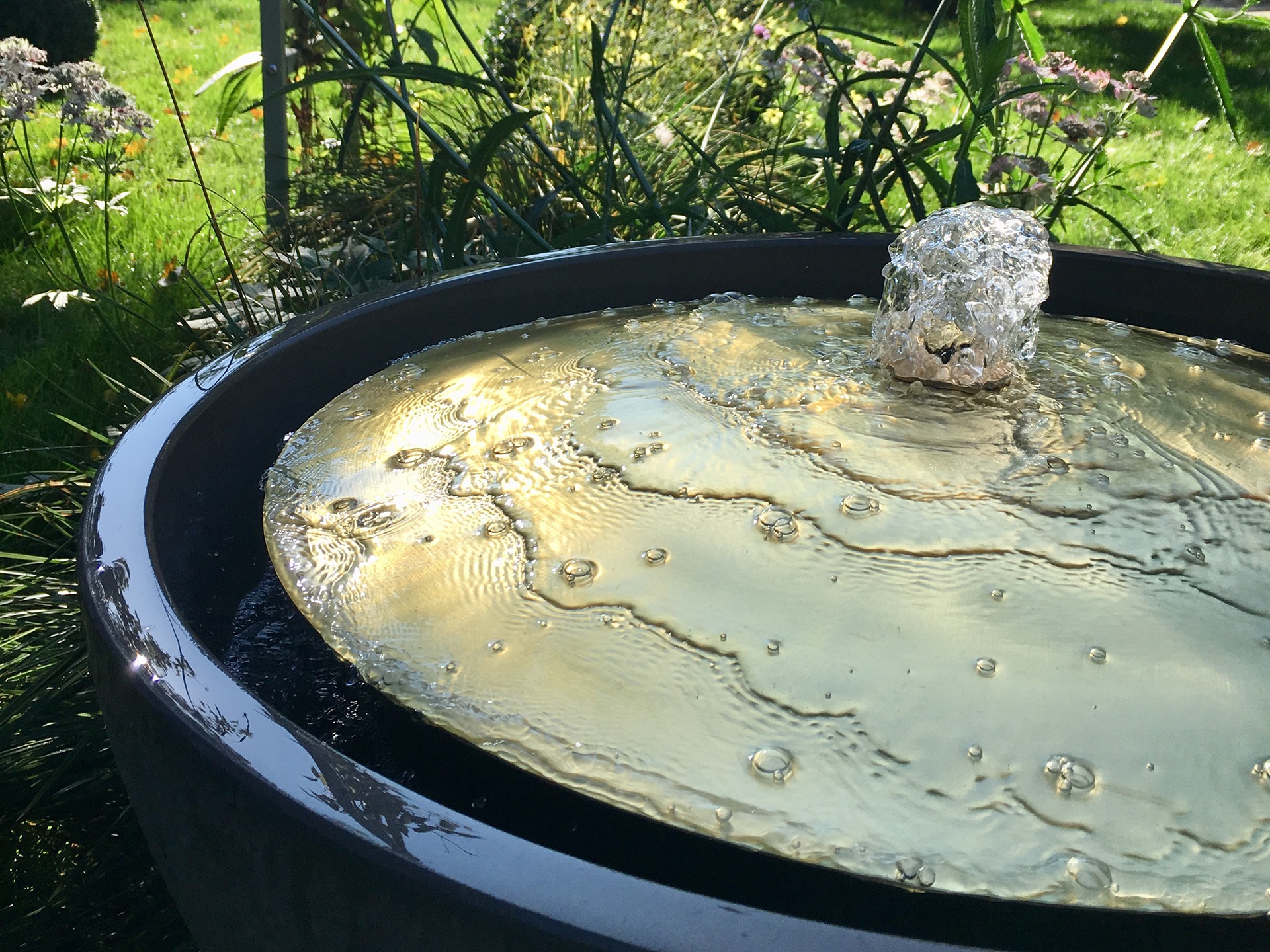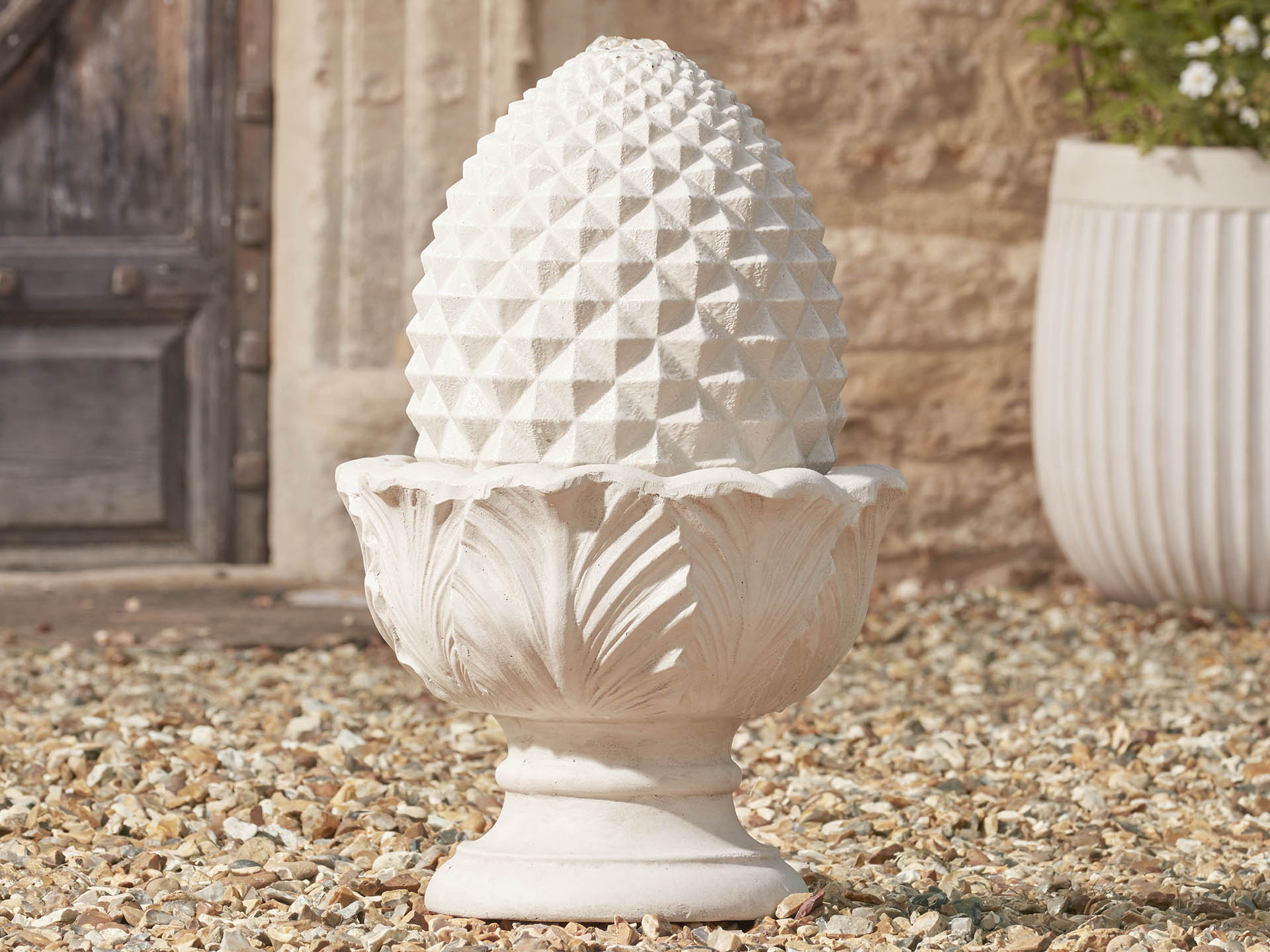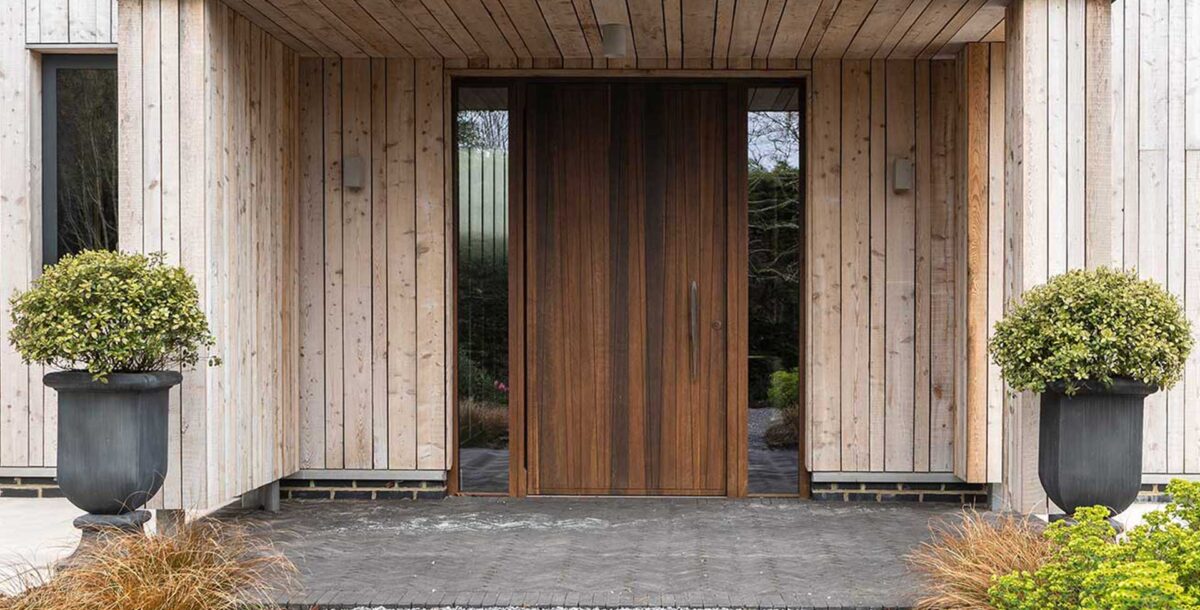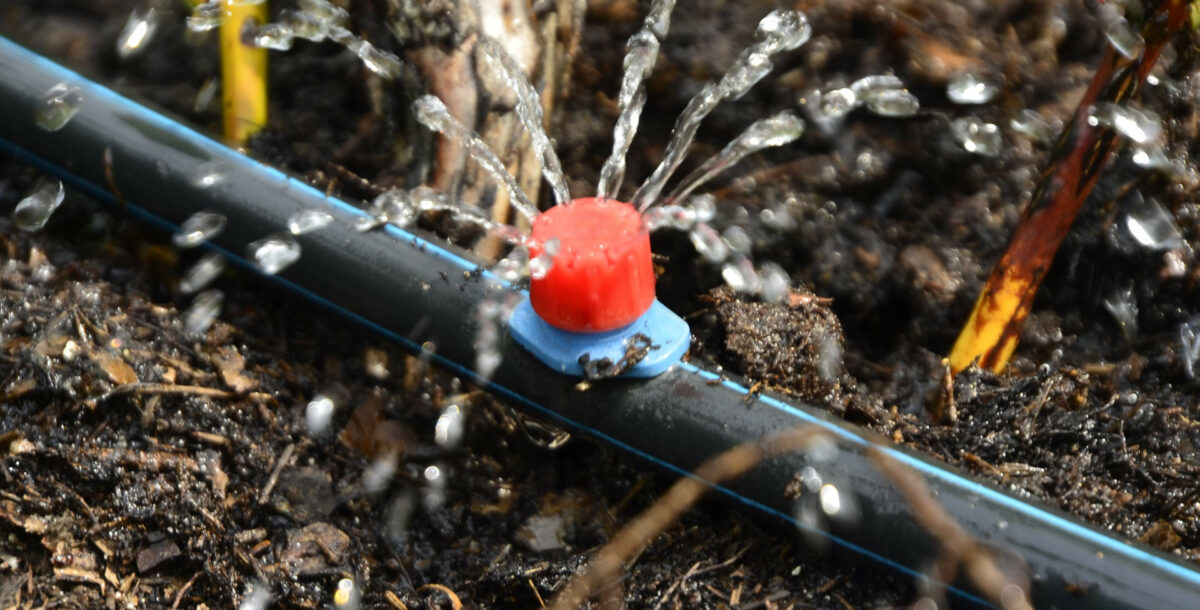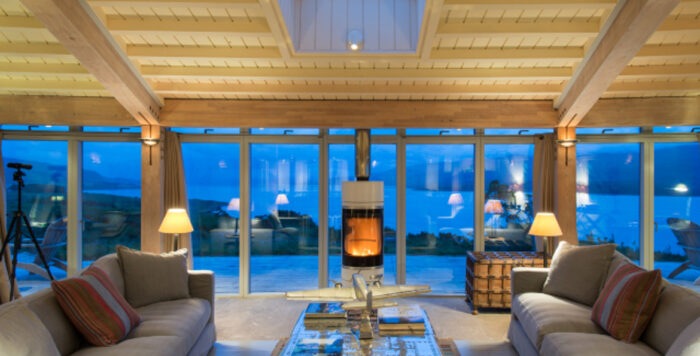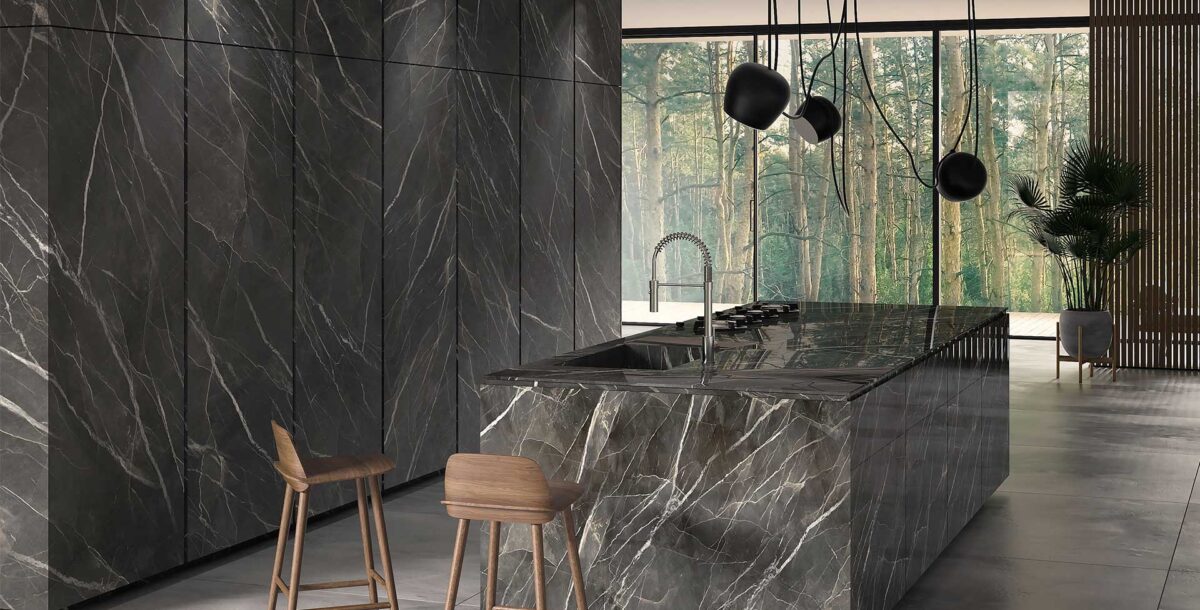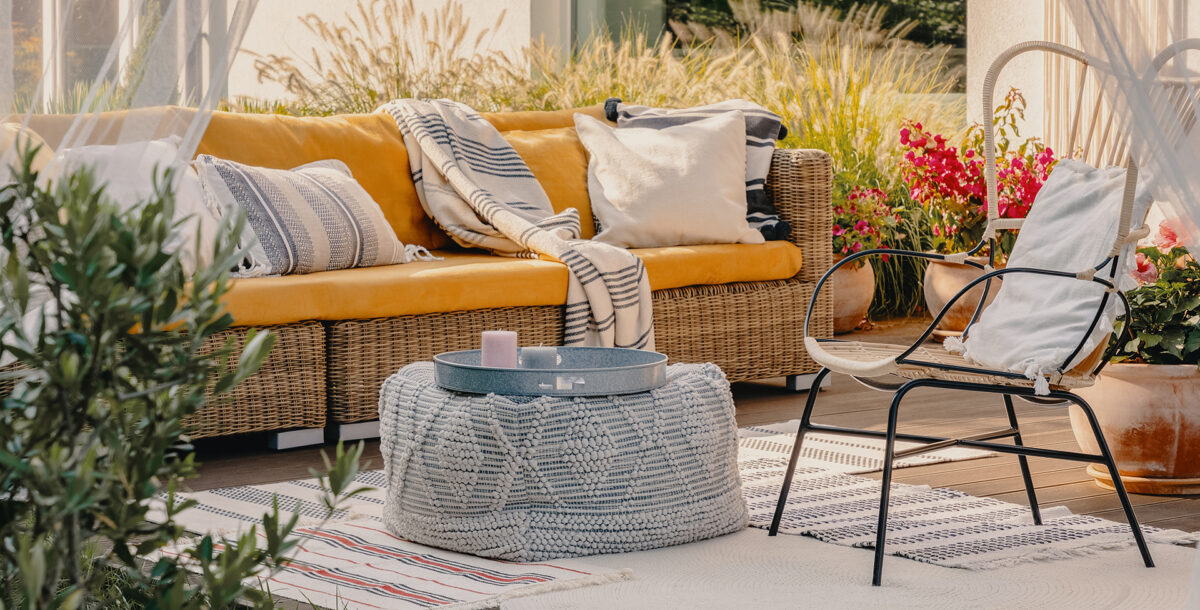Water feature ideas for any size garden
Whether you’re designing a new garden from scratch or thinking about giving your current garden a makeover, a water feature is a time-honoured way of enhancing an outdoor space. We’ve rounded up some of the most stunning designs and exciting ideas around to inspire you…
The Alhambra in Granada, Monet’s garden in Giverny, the Villa D’Este in Tivoli: think of the most celebrated gardens in history, and most of them contain water. There is something soothing to the frazzled soul about the presence of water in an outdoor space. The sound of water has now been scientifically proven to help us relax. Plus, as Will Haxby, from moulded-stone garden-feature supplier Haddonstone, points out, “As well as providing a focal point to create interest and draw the eye, water features, fountains and ponds can provide a self-sustaining ecosystem that will attract and sustain native wildlife in your garden.”
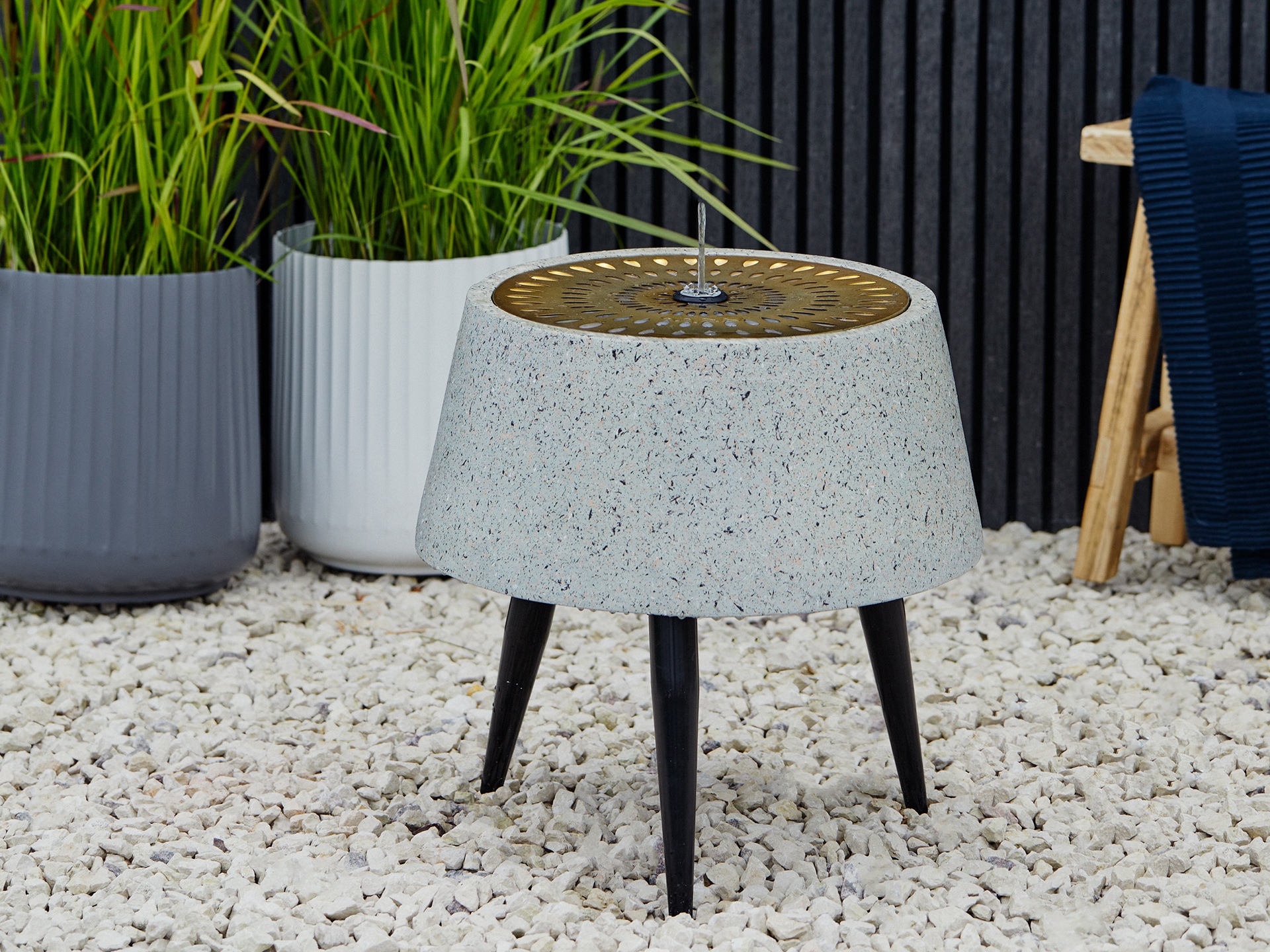
- Lime Lace, Solis water feature on a stand, terrazzo and brass, with light, £249.
Types of water feature
Nowadays, there are so many different ways to bring water into the garden, with options that will suit any size garden. Here are some of the main options.
Water blade
A long, thin wall-mounted box with a front lip. Water is pumped up to the box from where it spills out in a wide sheet, or blade, hence the water blade name.
Water table
A flat-topped water feature with a shallow pool or flow of water across the top, Fiona Jenkins, from trades-matching site MyJobQuote.co.uk, says, “If your garden is all on one level, a Corten-steel water table is a good alternative. Shaped like a box with a shallow surface of water and small bubbling fountains on top, it makes an eye-catching focal point. You can buy this type of feature with integrated LEDs, ensuring it’s a highlight in the evening too. You’ll find aluminium, zinc and granite versions of these cube-style water tables are also available, so you should have no trouble finding a finish that suits your garden and personality.”
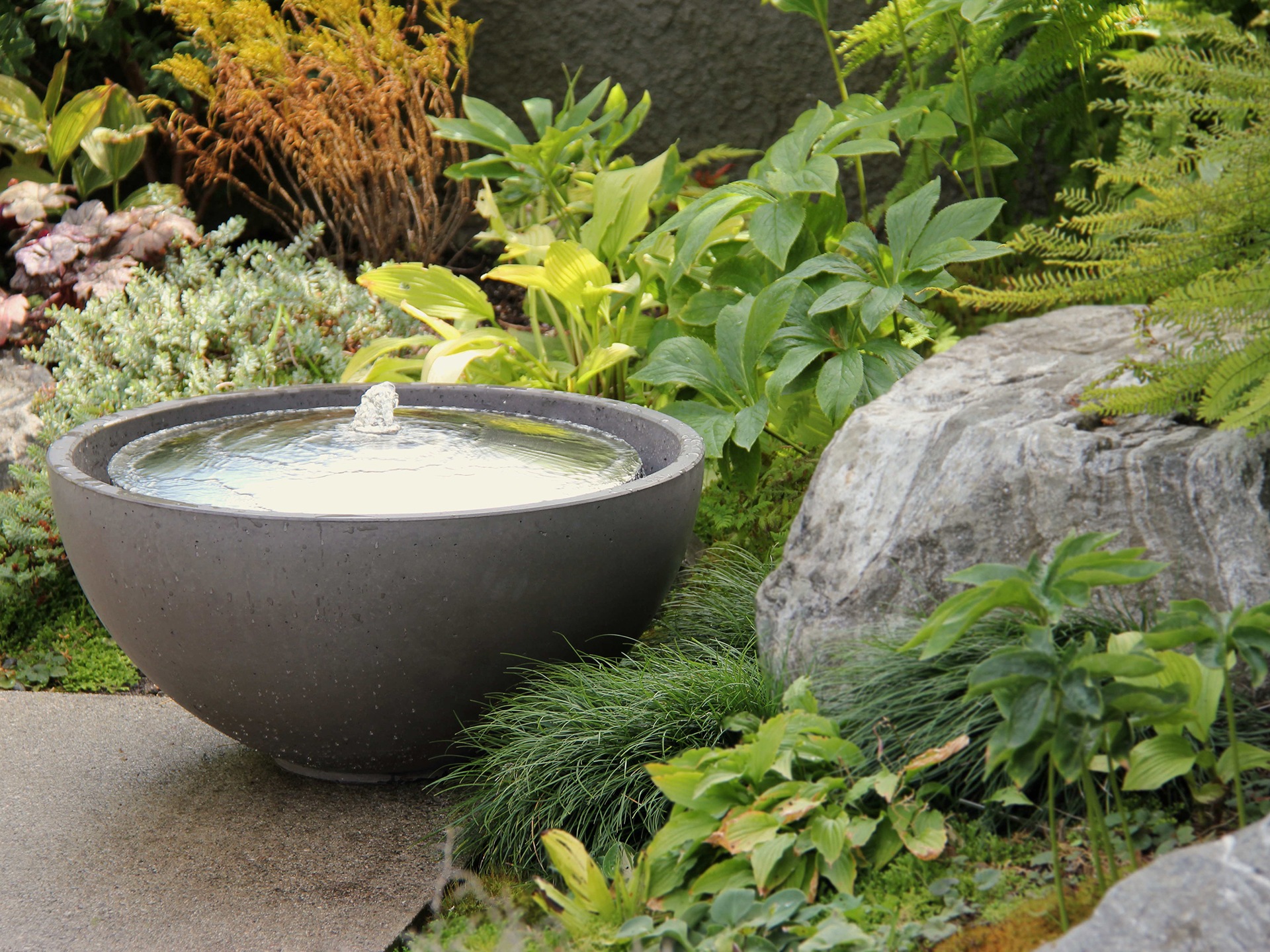
- Solus Decor‘s handmade hemispherical concrete bowls contain polished metal domes that appear to float inside the bowl creating subtle water movement, 48″ water dome, available in 12 colours, £3,900.
Rain curtain
A rectangular frame with holes in the top ‘cross bar’ that create a ‘rain’ curtain.
Water wall
A sculptural or structural piece, in which water runs down a wall,
Water bowls
Sonny Banham from contemporary garden feature company Rose and Rust, explains, “Water bowls can be used as a fountain, pond or simply as a decorative piece. A water bowl is generally shallow and wide in shape, and can vary in size, shape, material and style. They can be placed on the ground or on a raised platform or plinth to create more height and visual impact. Some water bowls can also be built into the ground to integrate into the landscape and give a more natural feel.”
Fountains
Will Haxby says, “Centrepiece fountains require a pond or pool surround underneath to capture the flow of water that falls from the fountain. Self-contained fountains work well in smaller areas such as courtyards and on patios. Easy to install and maintain, self-contained fountains require little space and are ideal for anyone considering purchasing their first water feature. Stone wall fountains offer lots of versatility and can be built into a new or existing wall with a pool or bowl underneath, or installed as a self-contained option. Available in a choice of sizes and styles to suit any space, wall fountains work well both to enhance outside spaces, and inside to breathe life into conservatories, orangeries, and pool houses. Nymphs, lions and characters from classical mythology are popular choices in traditional settings, whilst non-figurative styles work well in more modern landscapes.”
Ponds
Traditional, and a good way to add water to a garden, the humble pond can be a haven for wildlife.
Rills
These are long, narrow pools that carry water through the garden, almost like artificial streams.
Industrial style
The industrial look is as fashionable in the garden as it in architecture. This can be seen most clearly in water features built from Corten steel, a kind of ‘weathering steel’, an alloy specifically designed to rust over time to a give a stable rusty finish.

- Simply stunning Sandbanks Corten-steel water boxes from Rose and Rust.
Fiona Jenkins says, “Corten steel is a fantastic material to use in contemporary gardens as it develops a unique patina over time and provides a warm, coppery hue. A square, blade-style cascade made from this material works well in multi-level landscapes, creating a modern take on a classic garden waterfall. You can enhance this with steel gullies known as rills to extend your water feature through your entire garden.”
The rusty orange tones of Corten steel make a particularly beautiful contrast to green foliage. But if you prefer a sleeker, but still industrial look, many similar pieces are available in aluminium or stainless steel. Rose and Rust has a great range of Corten steel water features, and other Corten steel garden structures including its new Corten steel garden studio (below).
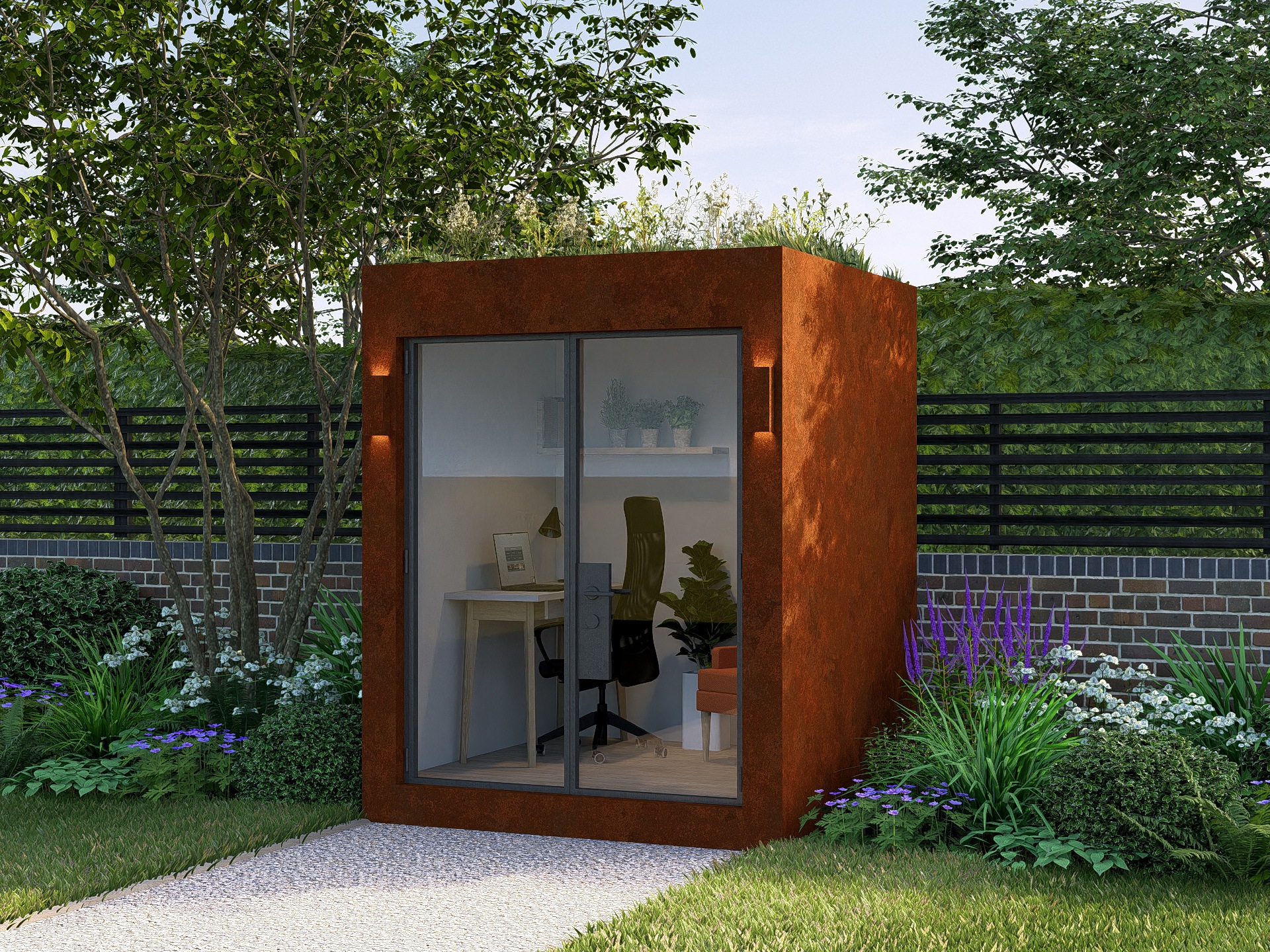
- The new Micro Pod garden studio from Rose and Rust is an innovative use of Corten steel. The pod with a living roof is all available in other finishes.
Minimalism
Minimalism is still a huge trend in garden design, and simple, sculptural spherical and cuboid water features work well alongside Modernist and contemporary buildings, and amidst all styles of planting. They also look good as a counterpoint to a more traditional home or garden. So, it’s easy to see why they remain popular.
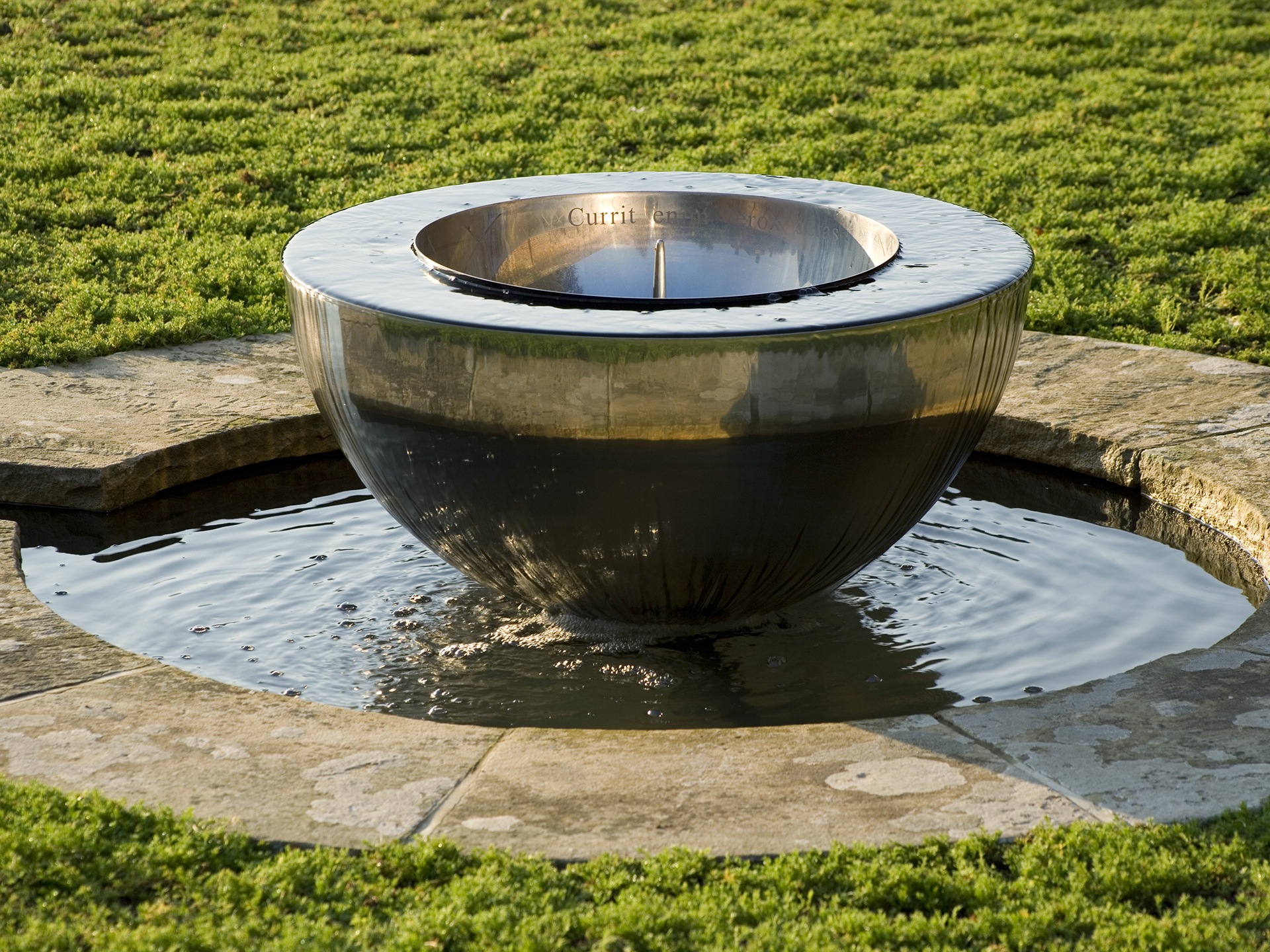
- Chalice by David Harber from £35,508 Flowing water clings to the polished outer surface, creating the illusion of a hemisphere slowly revolving on its axis.
Maximalism
How does maximalism, the interiors backlash against minimalism, translate into gardens? Dense, colourful, flower-heavy (and therefore pollinator-friendly) planting, with an eclectic mix of garden accessories. These might include colourful tiles and pots as well as antique or antique-style fountains, from a specialist such as Haddonstone. Garden centres are full of small, budget-friendly water features that would work well in a maximal garden.
Beautiful reclaimed fountains are available from reclaim and salvage yards, and are cheaper than you might expect (perhaps because they haven’t been as fashionable as minimalist designs in recent years) as well as being a sustainable choice.
Outdoor rooms
Another key idea in contemporary garden design is that of the outdoor ‘room’, for dining or simply relaxing. If climate change is going to bring hotter, drier summers, that will likely mean more warm summer evenings to enjoy outdoors. The sound of running water from a water feature can help create a sense of privacy in an outdoor living space, by masking noise pollution from roads and neighbouring homes, and creating a feeling of being in your own private outdoor space.
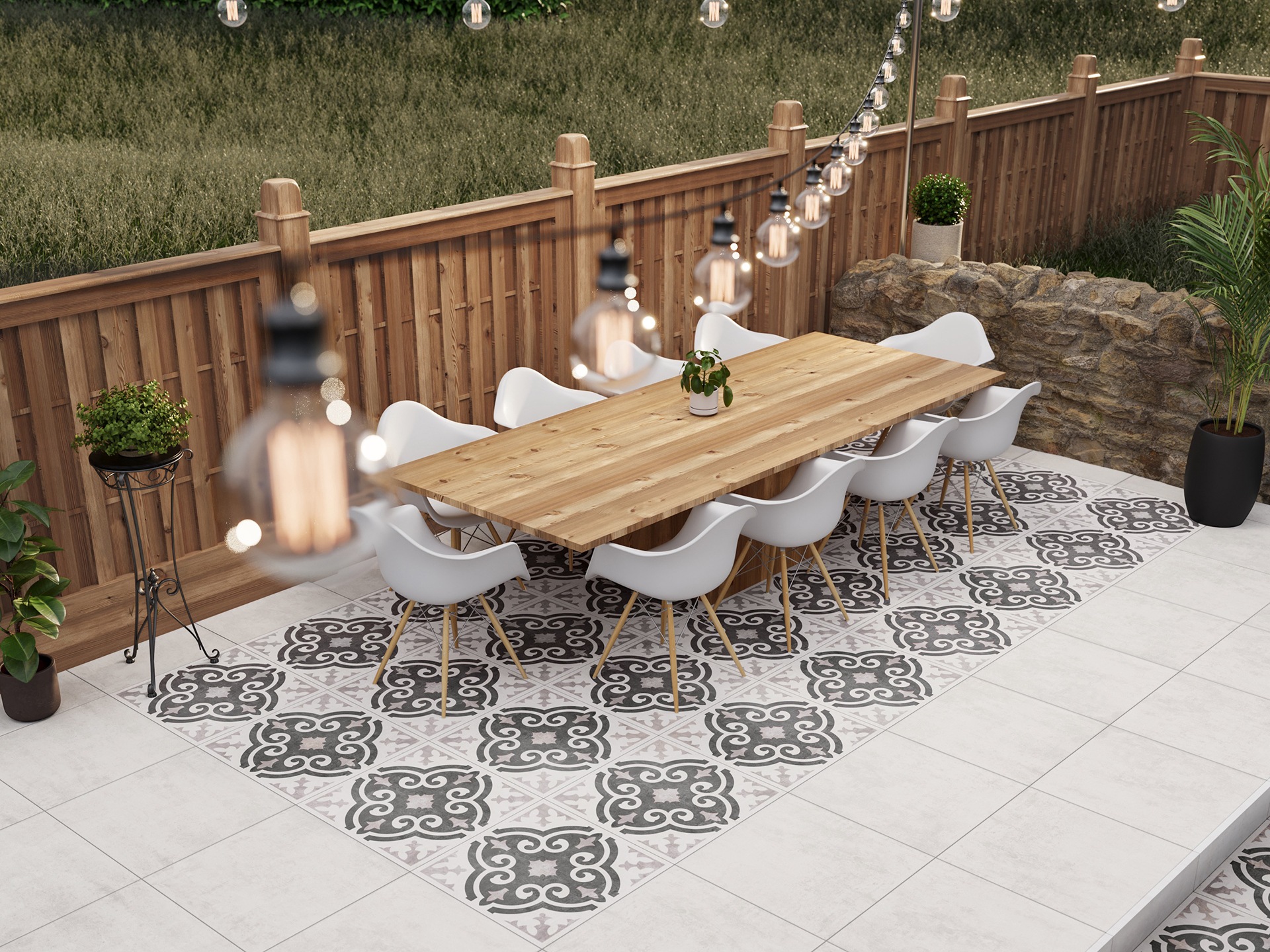
- An ‘outdoor room’ such as this one – featuring Porto Decor outdoor tiles from Tile Mountain, £25.99 per m2 – would be perfectly enhanced with the addition of a water feature, such as a water wall.
Lighting
Lighting can be used to enhance any water feature to make it into a focal point at night.
Solar features
Water features that run from integrated solar panels can be energy efficient and cheap to run. Some of them have a battery back-up for overcast days. These are also useful if you want to place a small water feature a long distance from a power supply. These types of solar fountains are typically not powerful enough for large water features.
Maintenance
When choosing where to put a water feature, try to avoid a position under trees, otherwise the water will end up full of fallen leaves in autumn. Any water feature will need some sort of pump in it to stop the water getting stagnant. You will also need to use a water-feature cleaning product in the water to prevent algae and slime from growing. Use a wildlife- and pet-friendly, chlorine-free one such as Fountain Safe from outdoor-living company Primrose. (The water purifying tablets sold to make water drinkable work too.) Primrose also makes a Frostfree additive you can pop into your water feature to stop it freezing. Again this is a wildlife and pet-friendly product. In hardwater areas you will also need to clean your water features to stop limescale build up. Just be careful to use a non-toxic product.
Will from Haddonstone advises, “Freezing conditions can cause serious damage to water features, in particular to the electric pumps. For this reason, it is important that water features are properly prepared for the onset of severe winter weather. Although many water features are frost resistant, they still require protection from freezing water. Ideally, water should be drained off before winter every year and not replaced until spring when any risk of hard frost has passed. If you are unable to fully drain down a fountain, other measures must be taken to ensure water does not freeze solid in the bowl. For example, during mild periods of frost, a tennis ball placed in a fountain bowl will gently agitate the water to prevent it from freezing. This is particularly important for pool surrounds, wall, bowl and trough fountains. Alternatively, smaller fountains can be emptied using a sponge before covering them to prevent them from filling with rainwater. The winter is also the ideal time to dismantle the pump for a thorough clean and any limescale should be scrubbed off using a mild, non-toxic detergent, paying particular attention to the impeller/rotor.”
Sustainable gardens
Another important current movement in gardening is, of course, the desire to garden more sustainably. This encompasses everything from avoiding peat products to an element of rewilding: gardening with nature in mind. If you have good DIY skills you could recycle or reuse materials to create a garden water feature.Take inspiration from the water feature below made out of a bath at the RHS Flower Show Tatton Park. If you are designing and making your own water feature though, do test it before you finally fix anything in place, to make sure that the sound it makes is gentle and soothing, not loud and intrusive.
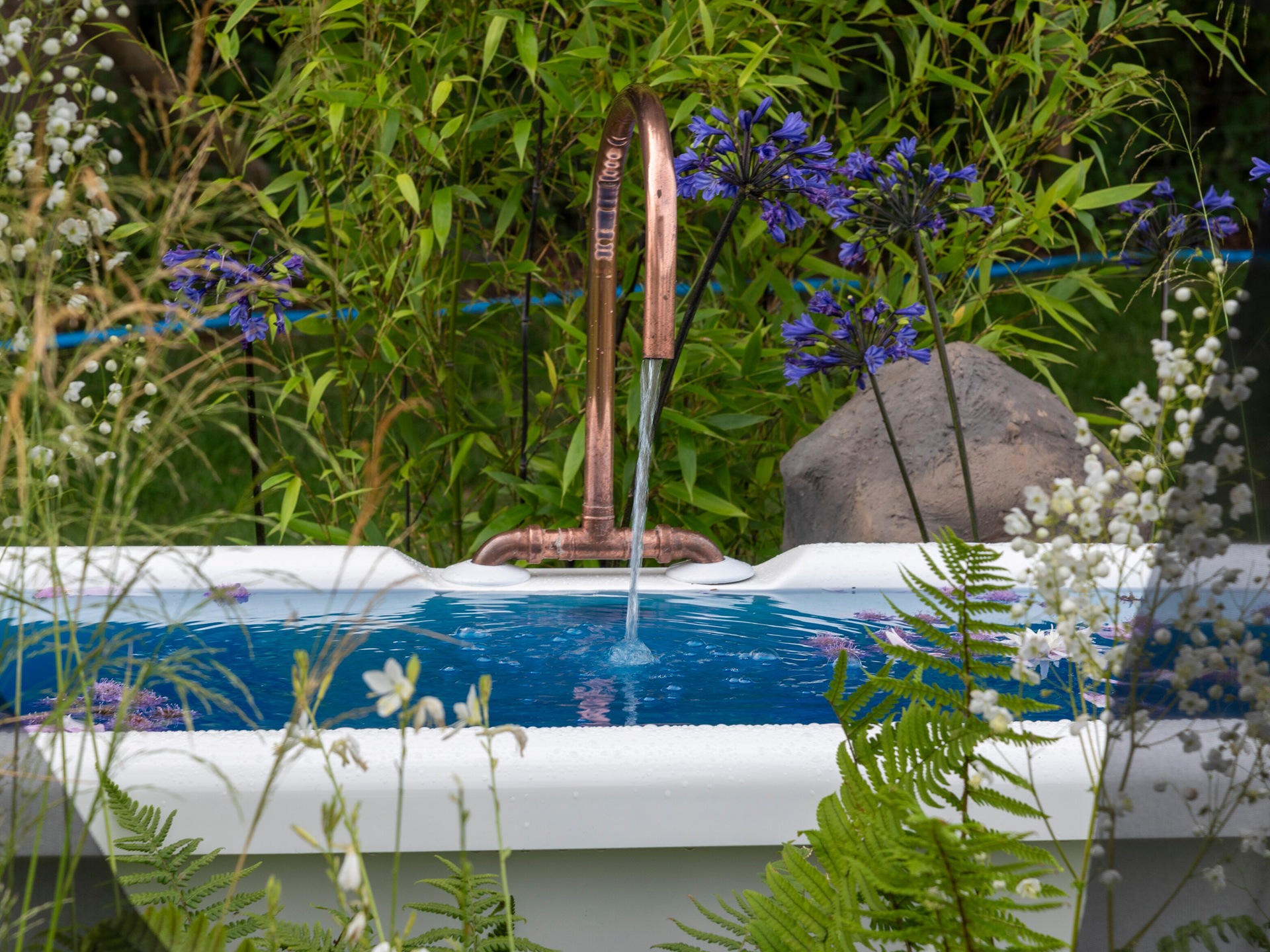
- A Pocket of Peace garden at RHS Flower Show Tatton Park designed by Daniel March, Hallie Abbott Trangmar and Adam Rowley.Image credit: RHS/Tim Sandall.
If you are collecting rainwater to use in your garden, what about a water butt that includes an integral water feature? These are available from Freeflush.
Charlotte Harris, co-founder and director of award-winning landscape-designers Harris Bugg Studio, says, “‘As we all face increasing pressures from a changing climate, with extreme and uneven patterns of rainfall, the water in our garden becomes ever more critical to birds, mammals, invertebrates and plant life. In parallel, careful design, use and storage of water becomes ever more important.
“But there’s no need to make compromises in the face of better environmental stewardship – in fact, in our view, it drives a more thoughtful and innovative design approach. Using rainwater-harvesting tanks to capture and recycle water reduces reliance on tap water and alleviates pressure on drainage systems. Harvested and treated rainwater can then feed features – whether formal, contemporary, or more naturalistic.
“In our work we’re increasingly celebrating the movement of rainwater – and this doesn’t have to be restricted to naturalistic rain gardens or ponds. In one current project we’re incorporating beautiful interlinked channels, rills, spouts, and tanks. Rather than concealing rainwater management underground, we highlight it as a feature, adding visual interest and narrative to the garden.
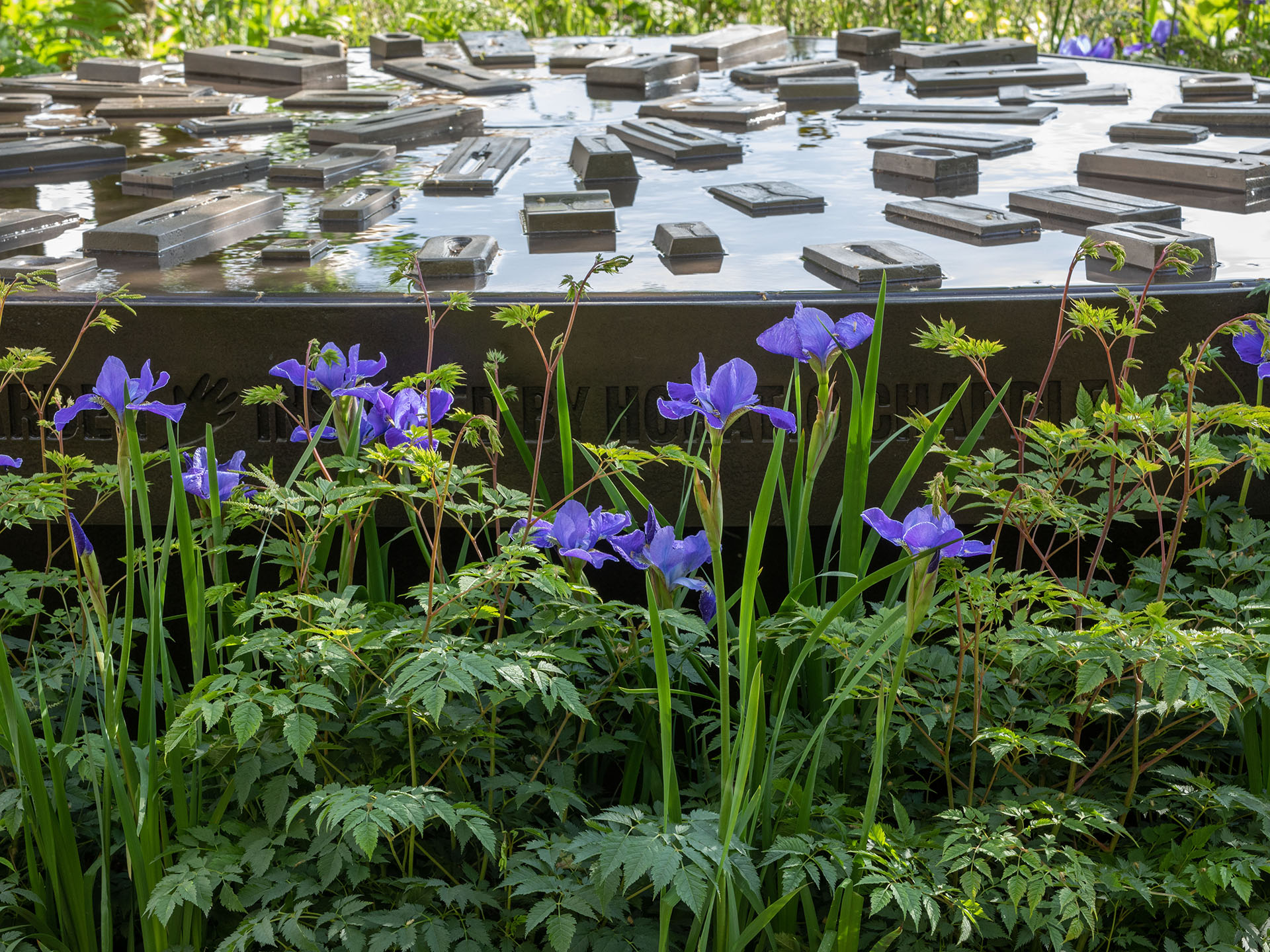
- Horatio’s Garden Chelsea 2023 designed by Charlotte Harris and Hugo Bugg. Iris sibirica Silver Edge, Aruncus Horatio. Photo © Marianne Majerus
“Water features can be designed to use minimal amounts of water while still providing stunning impact and attracting wildlife. One example is the water table we developed for Horatio’s Garden in Sheffield, influenced by the city’s cutlers heritage (above). This feature not only serves as a patient-friendly element at wheelchair height, but also provides a source of huge enjoyment for both patients and wildlife, as small birds love using it for bathing.”
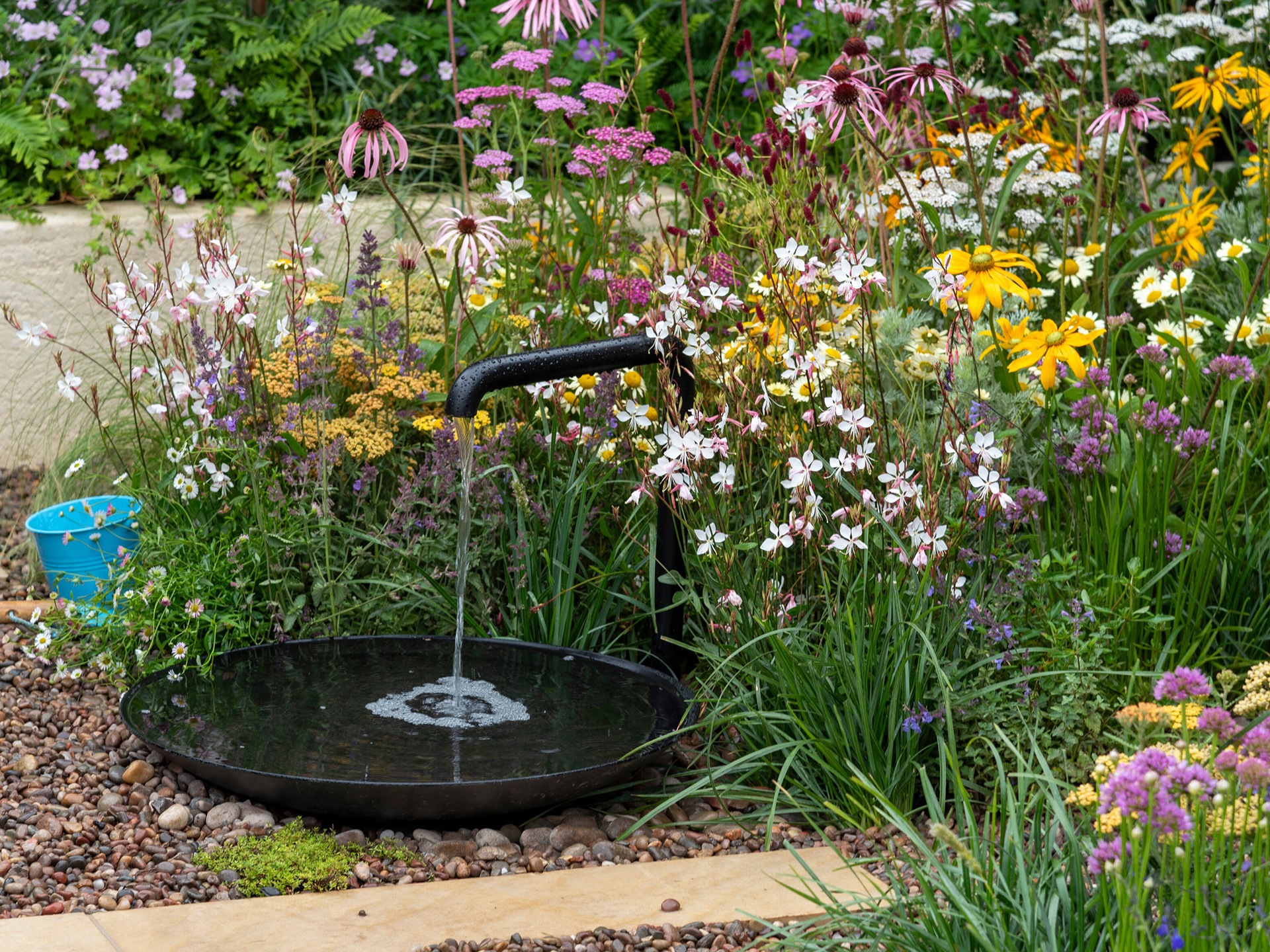
- The Balanced Garden. Designed by Amy Gunning. Terrace Garden. RHS Flower Show Tatton Park 2023. Image credit: RHS/Tim Sandall.
Water features with a purpose
As Charlotte suggests, water features in the broadest sense, don’t need to be just about making your garden look beautiful. They can serve a useful purpose too. As we begin to think about our gardens more holistically, manmade wetlands are being created in gardens as part of sustainable drainage systems, to help prevent flash flooding, and even as a natural means to treat waste water. You can find out more about manmade wetlands on the Constructed Wetlands Hub.
Water features for fun
Everyone knows how much children love to play in interactive water features and fountains, but adults do too given half a chance. So, what about water features large enough to splash around in? Do hot tubs and outdoor showers count as water features? Maybe they should… Check out this beautiful outdoor shower in a house extension in Salt Point in the US designed by artist Ai Weiwei and architects Reddymade. Or, on a larger scale, what about a natural swimming pool, like the one in Dan and Nina’s Grand Designs house in Chichester?
